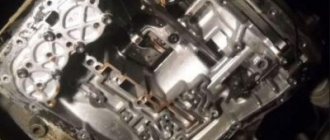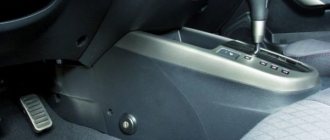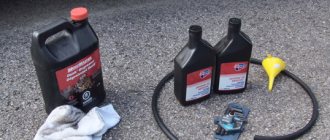An automatic transmission is a rather expensive and complex car unit. If its operation becomes incorrect and unpredictable, then there is no need to delay repairs. A malfunction of one box assembly may result in the breakdown of others. And automatic transmission repair in a car service center is very expensive.
Having studied the price range of the cost of services and comparing them with their capabilities and the profitability of the entire work, many car owners decide to fix the problems themselves. Moreover, prices in car repair shops do not always correspond to the quality of work to restore the functioning of the automatic transmission. Do-it-yourself repairs of such a complex unit should only be carried out armed with special knowledge.
Automatic transmission valve body and its purpose
The hydraulic unit, or hydraulic plate, is the control unit of the gearbox, one of its most complex components. It is a metal pan with milled channels in which control valves and solenoids are located. The latter ensure the operation of the gearbox. This unit controls clutch operation and gear shifting and, in turn, receives commands from the ECU.
Stove repair
Repairing the automatic transmission valve body yourself is possible, but it is not recommended due to the fact that the unit itself is very complex and has many systems that depend on each other. To restore the unit, you will have to completely remove the gearbox. Numerous valves are cleaned using special equipment. In addition, the operation of the mechanism drives the entire gearbox, and if it does not function correctly, much more serious damage is possible.
Therefore, you can repair the automatic transmission valve body yourself only if you have experience in carrying out such work. Fortunately, in addition to the plate in the gearbox, there are other components that can be diagnosed, troubleshooted and repaired. There may be differences between different car brands. Therefore, it is better to consider the features in order.
Causes of damage to the automatic transmission
Automatic transmissions are considered extremely reliable and durable. But if the automatic transmission is not operated correctly (incorrect driving mode) or switched incorrectly, then the service life of the transmission can be noticeably reduced.
However, proper operation of the automatic transmission does not guarantee 100% durability of the unit. The fact is that it is impossible to prevent material defects and wear of the automatic transmission due to heavy loads, such as climbing a mountain or constantly towing trailers with heavy loads. An unheated gearbox can also quickly lose its potential service life.
For example, if a cold box is subjected to high loads, it will wear out a lot. This is why the transmission should always be warmed up before driving on uphill roads or if you plan to haul a heavy trailer (trailers, horse trailer, or boat trailer). When the automatic transmission warms up before driving, the transmission oil will achieve optimal lubricity and prevent wear when driving under load.
As in a manual transmission, transmission oil in an automatic transmission ensures minimal friction for the mechanical components of the transmission, removes abrasive particles and protects its components from corrosion.
Unfortunately, just like motor oil, transmission fluid in your transmission requires regularly scheduled replacement. If you do not change the oil in the automatic transmission, then due to the loss of properties of the oil inside the box, higher friction will occur between the parts, which, consequently, will cause greater wear on all components of the transmission. As a result, some individual transmission components may overheat and even fail.
Meanwhile, you should remember that not all automatic transmissions are equally reliable. Over the long history of the auto industry, the auto world knows many examples of automobile companies producing, frankly speaking, unsuccessful units. This also applies to gearboxes. Especially automatic ones. Thus, it has long been known that, for example, gearboxes such as Audi's Multitronic (as well as almost all dual-clutch gearboxes) are not very reliable and have a short lifespan. By the way, these gearboxes (DSG) are offered by car manufacturers under different names.
For example, Renault calls them “EDC” (Efficient Dual Clutch). Porsche called the dual-clutch transmission “PDK” (Porsche Doppelkupplungsgetriebe). In Ford cars, this type of gearbox is called “Powershift”. Audi has S Tronic.
Unfortunately, damage at 60,000 kilometers or more is not unusual for these types of transmissions.
Features of Toyota automatic transmission repair
Before you repair the automatic transmission yourself (Toyota Camry is no exception), you should determine the malfunction.
Breakdowns and operational problems of all automatic transmissions are as follows:
- Hydraulic problems.
- Mechanical problems.
- Electronics malfunctions.
Correct diagnosis is half the success in your work. In any case, repairs involve removing the gearbox from the car and partially or completely disassembling it. Before removing the gearbox, you must turn off and dismantle the oil pump and check its bearings. Then they look at the friction block for the integrity of its parts. Next, check the drum for damage or overheating. After this, the planetary mechanism is diagnosed for the presence of worn clutches or bearings. After installing the gearbox, lubricant is poured into it and the car is warmed up to drain all excess oil.
Features of Honda CR-V automatic transmission repair
It is better to entrust its repair to professionals, but there are some things you can do yourself. Just like for other cars, the automatic transmission is removed from the car. To do this, you need to dismantle the subframe, wheel drives and lower arms with stabilizer. After this, the unit is removed from the car and disassembled. The essence of gearbox repair comes down to its disassembly and troubleshooting. It is mandatory to check the condition of the torque converter to check the integrity and degree of wear of the parts.
Then the condition of the clutches is checked. They fail most often (due to excessively active driving with sudden acceleration and braking). All attachments are installed on the assembled box, a torque converter on one side and a transfer case on the other. The entire unit is placed on the car, and after that everything is assembled in the reverse order. Please keep in mind that this job requires at least some experience. Repairing a Honda CR-V (automatic transmission) with your own hands is quite difficult. In some cases, you still have to turn to professionals.
Removing the box
So, first of all, let's look at the procedure for removing an automatic transmission from a car. Typically, the procedure is carried out as follows:
- First, we completely drain the oil from the box or plug all the holes from which it may leak, but the first option is much preferable;
- Then we uncouple the third-party components of the car from the automatic transmission. These include the oil system, control rods, cables and electrical circuits connected to the box. We do not disconnect the torque converter from the mechanism and remove it together with the gearbox;
- We find the bolts securing the automatic transmission to the engine and car body and, having attached the removable mechanism to the box, carefully unscrew them. Be sure to make sure that the prepared puller is reliable and can withstand the weight of the gearbox, which is often 60-100 kilograms;
- After all the fasteners are unscrewed and the automatic transmission is freed, carefully remove it from the shafts of the engine and the entire car;
- Then all that remains is to put the box in the disassembly area.
Advice! When removing an automatic transmission from a car, enlist the help of two or three assistants, one of whom should support the torque converter, and the others should support the transmission itself.
Repair of automatic transmission of Honda cars
Of course, if you have some experience and special tools, you can try to repair a Honda automatic transmission yourself, but this is fraught with many difficulties. An automatic transmission is one of the most complex units in a modern car, and disassembling it, and most importantly, subsequent correct assembly is a responsible and time-consuming task. But with a clear action plan, anything is possible.
First of all, you should carry out a correct diagnosis and find out what is causing the automatic transmission to malfunction. Do-it-yourself repair of this unit involves removing it from the car and subsequent disassembly with mandatory troubleshooting and replacement of all worn parts. If the car is old and has a high mileage, then you need to be prepared for the fact that many consumables have become unusable. In addition, all gaskets and seals must be replaced during disassembly. Otherwise, oil may leak, which will further aggravate the situation.
Assembly is carried out strictly in the reverse order. After installing the box, you should fill in new oil and warm it up by starting and stopping the engine several times. The gearbox is checked for leaks. If everything is done correctly, the transmission will work for a very long time if used correctly.
Cost of replacing transmission oil in a gearbox
The cost of changing the oil in an automatic transmission consists of the cost of the oil, filter and working time spent by the technician. Prices for gear oil depend on the type of fluid used in the box. On average, oil in a box in Russia costs 1000 rubles per 1 liter. There are, of course, both more expensive and cheaper oils. You must decide what kind of oil to put in the box individually.
It all depends on what kind of oil and with what tolerances your car manufacturer recommends using. We also recommend reading several automotive forums, where people usually write reviews about the use of this or that oil. The final cost of the oil you need will depend on how much transmission fluid your car's automatic transmission holds.
As for the work, on average, changing the oil in an automatic transmission will cost you 1,000 rubles. Naturally, if you change the oil in a private garage, the work will cost less. If from the officials, then prepare 2-3 times more money.
It is worth noting that usually in addition to the work of changing the oil in car services, they also add the work of flushing the automatic transmission.
BMW automatic transmission repair
BMW cars are in steady demand, and there are many reasons for this. Unfortunately, automatic transmission malfunctions happen here too. The reasons are most often the same as on other cars. These are violations of operating conditions, jerky, harsh driving, high mileage. In some cases, it is quite possible to repair a BMW automatic transmission yourself if you have the necessary tools, experience and the necessary spare parts.
Work should begin with determining the nature of the malfunction. After this, the automatic transmission is removed from the car for disassembly. Please note that since BMW cars are rear-wheel drive, to remove the automatic transmission on some models you also have to remove the driveshaft. Most often, clutches and linings, valve springs in the valve body fail, the oil pump leaks or fails, and bearings in the clutch block wear out. All these details are checked.
Worn elements must be replaced. If the automatic transmission does not work properly, they have a strong wear and tear: burnt clutches, for example, are clearly visible by their color.
When reassembling, it is imperative to follow the order of work. In such a complex unit, many parts depend on each other. Subsequent repairs may no longer be possible.
Recommendations for use
- Eliminate slippage. The automatic transmission must be operated without slipping, otherwise this will significantly reduce its service life. This is especially true for those who like to drift on ice. Regardless of the road surface, the possibility of slipping is excluded.
- If this is your first time using a machine, keep in mind that the neutral speed on it does not just turn on. The neutral mode is activated only when the car is parked without the engine running; in other cases it cannot be turned on.
- Vehicles with automatic transmissions cannot tow other vehicles. The same goes for trailers. Installing a trailer or other vehicle in tow will negatively affect the service life of the vehicle as a whole.
- Automatic transmission never. Over time, this can lead to complete failure of the unit. The same applies to towing a car - if for some reason you cannot start, then your only option to get to the service station is to call a tow truck. If the box suddenly starts working in emergency mode, but at least somehow works, then you need to go to the nearest service station. We strongly do not recommend driving for more than 5 kilometers with an incorrectly functioning gearbox.
Features of Audi transmissions
Do-it-yourself automatic transmission repair of Audis from different years of production is also possible if you have a solid technical base and tools. It should be noted that in this car with an automatic transmission the symptoms of malfunctions are similar to those of other manufacturers. This is wear of the clutches, leaking oil seals or worn out bearings, improper operation of the electronics or hydraulic parts.
Removing an automatic transmission differs from other manufacturers in that on many Audi models the engine is located along the body. Therefore, the design of the gearbox itself is different from others. However, the principles of automatic transmission repair on cars of this brand are the same as on others. Therefore, the malfunctions are the same for all automatic transmissions.
Just like on other units, due to overheating, clutches fail, individually or as a whole package, bearings and seals wear out, and insufficient oil pressure in the valve body leads to unclear gear shifting. Particular attention should be paid to the torque converter. Its wear is clearly visible after removal.
A special feature of the Audi automatic transmission is the design of the clutch packs. They are separated for each transmission. It should be borne in mind that during disassembly you will have to change the pan gaskets, pump and seals.
Signs of breakdown
Problems with automatic transmissions are divided into electrical faults or hardware wear. You can detect a breakdown by hearing, smell and sight. The automatic transmission should switch smoothly, quietly, without delay. The appearance of uncomfortable sensations indicates improper operation of the transmission.
A fluid leak or “Check Engine” signal is a clear sign of problems with the gearbox. If you do not pay attention to the signs that the car gives, the automatic transmission will fail and force the owner to fork out for expensive repairs or replacement.
| Sign of breakdown | What to do |
| Oil leak. | Look for the source of the leak: · inspect the bottom; · check the tightness of the drain plug; · if oil leaks between the engine and automatic transmission, you need to disassemble the torque converter. The problem is the oil seal, oil pump bushing, or damage to the donut housing. |
| Overfilling or underfilling oil. | Adjust the level. If you drive for a long time with the wrong fluid level, the gearbox begins to starve of oil and wears out quickly. |
| The oil is opaque, with a burnt odor. | Go through the machine. Replace bearings, bushings, automatic transmission clutches. Clean the valve body and solenoids. Check the condition of the planetary gear. |
| The tray contains large metal or plastic particles and a lot of chips. | |
| Delay when switching, hesitation when overtaking, lack of switching. | Clean the valve body and solenoids. Replace consumables. |
| Jerks, jerks, impacts while shifting gears. | Clean the valve body and solenoids. Replace consumables. Check the clutch clearance and the condition of the pistons. |
| The engine stalls during the transition to "D". | Check the wheel blades of the torque converter and clean the valve body. |
| Jerking, jerking while moving. | The freewheel in the torque converter is faulty |
| Automatic transmission slipping, i.e. When the car accelerates, the speedometer and tachometer needles do not move synchronously. | Clean the valve body and solenoids. Replace consumables and clutches. |
| During acceleration, engine speed fluctuates, acceleration is slow. | Check the torque converter wheel blades. |
| Computer errors, emergency mode. | 1. Go through the box. Errors occur when the wiring, sensor, or solenoid are damaged. 2. The software may be outdated; you need to reset the adaptation. |
| There is no reverse movement, or any speed, or if the car does not respond to the gas pedal. | Check the torque converter and the corresponding clutch package: clutches, pistons, O-rings, brake band, drum housing |
You can analyze the signs of a breakdown only by knowing the structure and operating principle of the automatic transmission. For example, in what cases does slippage occur:
- when starting, but then it drives normally. Most likely the problem is the wear of the donut hub. The splines are very worn out, and at high speeds the shaft slips;
- during ascent at 5 - 8 speeds. Slipping occurs due to a lack of fluid or severe wear of the oil pump or valve body;
- when changing gears. Clutches slip due to lack of oil or problems with solenoids.
https://youtu.be/Z3ck1MSxpeM
Nissan automatic transmission repair
Just like on Toyota, Nissan's automatic transmissions are famous for their reliability, but age and improper operation make these units unusable. The causes of malfunctions may be the following:
- Electronic malfunction.
- Mechanical problems.
- Malfunctions of hydraulics and switching mechanism.
All work begins with diagnostics, and only after correct identification of the fault is repair carried out. But often the fault cannot be localized and can only be corrected by rebuilding the box (for example, turning off one of the gears from time to time). In this case, if you have experience in this kind of work, you can repair the automatic transmission (Nissan) yourself.
Disassembling the transmission is the same as on other cars. It should be noted here that automatic transmissions installed on Nissan cars are very durable and require repair very rarely. Therefore, the restoration of such a gearbox will come down to replacing almost all worn parts. They change units - a torque converter, a clutch pack, a filter and a brake band. As for the valve body and electronic control unit, all malfunctions in this area are typical for all modern automatic machines.
How to independently diagnose (defect) an automatic automatic transmission
Self-diagnosis of automatic transmissions should be carried out in a certain sequence.
Steps to check an automatic transmission:
- checking the transmission fluid level, gearbox characteristics and condition;
- quick check of the functioning of the internal combustion engine in idle mode, connectors and condition of the wiring, stage selection cable and throttle cable;
- reading fault codes of engine and automatic transmission control units;
- checking the functioning of the vehicle at full engine power and a complete stop;
- diagnostics when driving in different modes;
- checking the pressure level in the control system.
Without visiting a service station, you can check your car for errors using the Rokodil ScanX universal scanner.
The device comes with detailed instructions for connecting it and selecting software.
Checking the throttle cable
The cable that controls the throttle valve connects the control mechanism of the box with the throttle assembly or fuel injection pump control. A long period of operation leads to damage to the cable sheath, its drying out, shortening and coming out of the fastening.
Repair of automatic transmission of Mazda cars
The automatic transmission of Mazda cars is traditionally famous for its reliability, but they also have weaknesses. In particular, this is the friction lining in the torque converter, which during its operation clogs everything around it. The solenoid block also often burns out and the Teflon o-rings wear out. In the first case, the box begins to shift gears incorrectly. In the second case, there is an oil leak from the transmission with all the ensuing consequences.
Clutch clutches also often burn out, albeit after a long mileage. Burning of the friction linings causes a chain reaction, and soon they all fail. On Mazda cars, it is quite possible to do automatic transmission repairs yourself, but this requires good qualifications and a clear understanding of the actions. It should be noted the exceptional reliability of the control electronics and valve body, which very rarely require mechanical intervention.
Features of Ford automatic transmission
known for being the first to begin developing automatic transmissions in general, and modern models do not lag behind in quality and reliability. A characteristic feature is that the transmission installed on the Ford Focus allows for maintenance and repairs without removing it from the car. Thanks to this, it is possible to repair automatic transmissions of various Ford models with your own hands.
The weak point (on many Focus models as well) is the friction clutches, which wear out due to oil starvation, which can begin when the drum seat wears out. How to repair automatic transmissions yourself? The brake band on these transmissions must be changed during overhaul, since it wears out quickly. Many Ford models are equipped with the same automatic transmission as Mazda cars. Therefore, wear of the Teflon sealing rings also occurs here. Also a weak point are the solenoid blocks in the valve body.
Precautions for servicing and operating automatic transmissions
Automatic transmissions, being complex mechanisms, have an increased margin of safety and reliability. After all, their repair is not only expensive, but also very labor-intensive. With proper operation, smooth, careful driving, and timely maintenance, an automatic transmission can operate without repair for at least 200 thousand km.
Old Japanese automatic machines from the early 80s still drive without major repairs, having covered more than a million kilometers. Therefore, many problems associated with repairs can be avoided simply by following the operating instructions.
Changing transmission oil in an automatic transmission
To avoid damage to the automatic transmission, it is necessary to change the transmission oil regularly. Although many automakers often tell car owners in their manuals and service books that the automatic transmission is filled with oil for its entire service life, as a result of which the transmission does not require maintenance. But remember that the laws of physics and chemistry have not been repealed.
Oil does not last forever and as the car is used, it naturally loses its properties, which will ultimately, sooner or later, affect the service life of the gearbox. Thus, as the vehicle's mileage increases, the oil becomes contaminated and loses viscosity and lubricity. The condition of the oil is also affected by driving style and operating conditions (load, climatic conditions, etc.). All this, of course, can significantly reduce the service life of the automatic transmission if the oil is not changed in a timely manner.
This is especially true for expensive gear oil, which, as a rule, has a high proportion of various chemical additives that provide the oil with a longer service life without loss of chemical properties. Nevertheless, such oils also lose their properties over time due to the cessation of the additives. As a result, even in boxes with expensive oil, it is worth changing the transmission fluid after 80,000-100,000 km.











